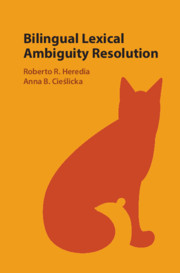Book contents
- Bilingual Lexical Ambiguity Resolution
- Bilingual Lexical Ambiguity Resolution
- Copyright page
- Dedication
- Contents
- Figures
- Tables
- Contributors
- Preface
- Acknowledgments
- Part I Theoretical and Methodological Considerations
- Part II Bilingual Lexical Processing
- Part III Bilingual Sentence Processing
- Part IV Neuroscience of Bilingual Lexical Access
- 9 Behavioral and Neural Correlates of Bilingual Lexical Ambiguity
- 10 Electrophysiology of Semantic Violations and Lexical Ambiguity Resolution in Bilingual Sentence Processing
- 11 Studying Bilingualism Through Eye-Tracking and Brain Imaging
- Author Index
- Subject Index
- References
11 - Studying Bilingualism Through Eye-Tracking and Brain Imaging
from Part IV - Neuroscience of Bilingual Lexical Access
Published online by Cambridge University Press: 24 December 2019
- Bilingual Lexical Ambiguity Resolution
- Bilingual Lexical Ambiguity Resolution
- Copyright page
- Dedication
- Contents
- Figures
- Tables
- Contributors
- Preface
- Acknowledgments
- Part I Theoretical and Methodological Considerations
- Part II Bilingual Lexical Processing
- Part III Bilingual Sentence Processing
- Part IV Neuroscience of Bilingual Lexical Access
- 9 Behavioral and Neural Correlates of Bilingual Lexical Ambiguity
- 10 Electrophysiology of Semantic Violations and Lexical Ambiguity Resolution in Bilingual Sentence Processing
- 11 Studying Bilingualism Through Eye-Tracking and Brain Imaging
- Author Index
- Subject Index
- References
Summary
Language is full of ambiguities, ranging from challenging phonetic contrasts to homophones and homographs. While some ambiguity is inherent in any language, the challenge of resolving linguistic conflicts is even greater for those who speak multiple languages. The question of how bilinguals represent and control their two languages has been addressed using various methodologies ranging from case studies of multilingual aphasics to advanced neuroimaging techniques. In this chapter, we focus on two methods in particular that have contributed to the understanding of bilingual cognition. First, we review evidence from eye-tracking studies demonstrating that bilinguals activate their two languages in parallel. We follow with a discussion of fMRI research investigating whether different languages have shared or separate representations in the brain. Finally, we examine the processes underlying language control and discuss the ways in which different methodologies can contribute to our understanding of bilingual language processing.
Keywords
- Type
- Chapter
- Information
- Bilingual Lexical Ambiguity Resolution , pp. 273 - 299Publisher: Cambridge University PressPrint publication year: 2020
References
Further Reading
References
- 1
- Cited by

